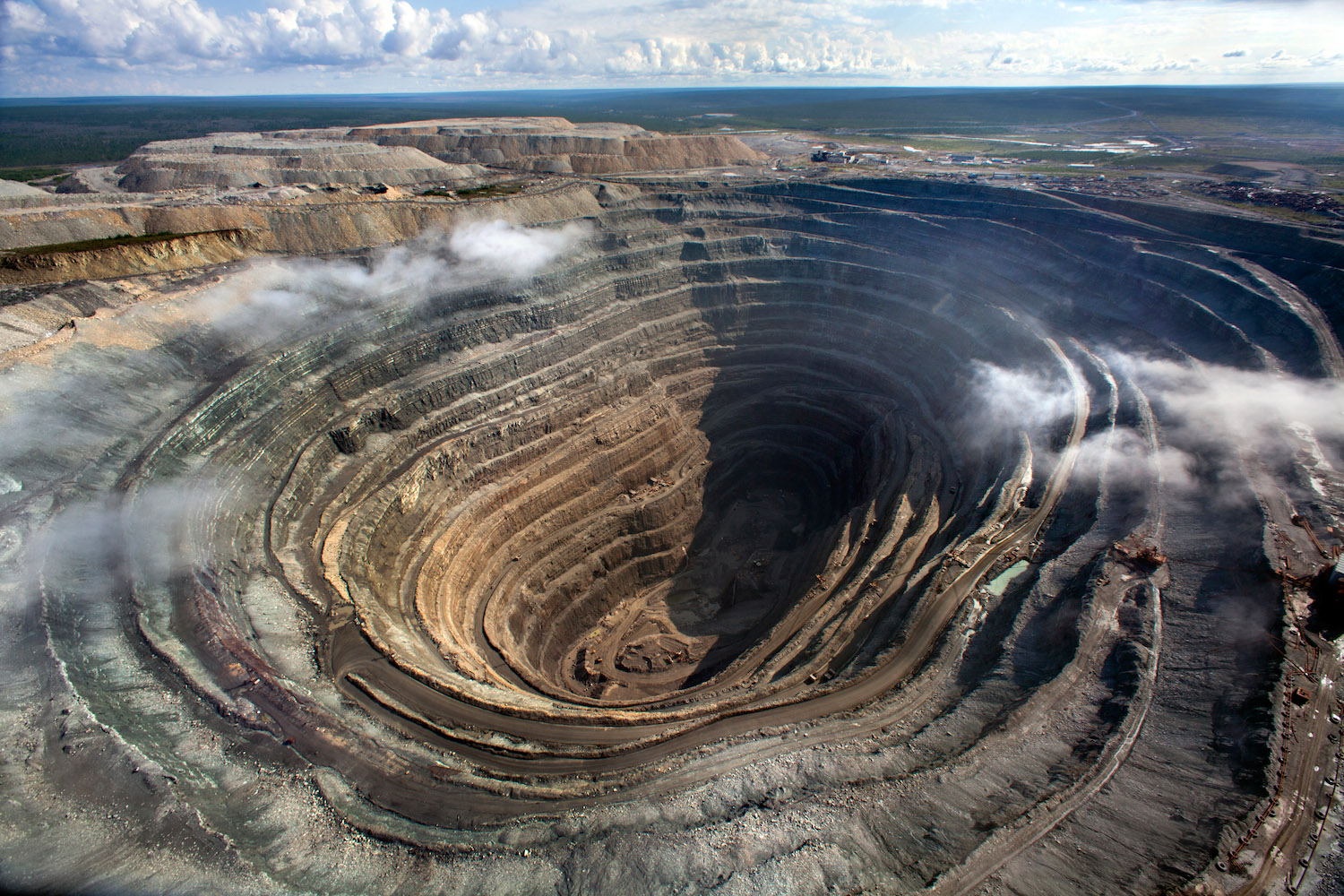Mining and Extraction

Diamonds pit – The extraction of diamonds from the earth’s crust is a complex and multifaceted process. It involves the use of specialized techniques and equipment, as well as a deep understanding of the geological formations in which diamonds are found.
Diamond mining operations typically begin with the exploration of potential diamond-bearing areas. This involves geological surveys and geophysical techniques to identify areas with the highest probability of containing diamonds. Once a promising area has been identified, a mining plan is developed.
In the depths of the diamonds pit, the earth’s heart beats with a fiery pulse. But beyond these subterranean chambers, another pit awaits, where fortunes are not mined but gambled. The casino pit beckons with its flickering lights and the tantalizing promise of riches.
Yet, like the diamonds pit, it is a place of both allure and danger, where dreams can be shattered as swiftly as they are born. But as the sun sets, casting a golden glow over the diamonds pit, its allure remains, a constant reminder of the irresistible pull of both the earth’s depths and the seductive embrace of chance.
Open-Pit Mining
Open-pit mining is the most common method of diamond mining. It involves the excavation of a large, open pit in the earth’s surface. The overburden, or soil and rock that covers the diamond-bearing rock, is removed using heavy machinery such as bulldozers and excavators.
Once the overburden has been removed, the diamond-bearing rock is exposed. This rock is then broken up using explosives or mechanical methods, and the diamonds are extracted from the broken rock using a variety of techniques, including screening, washing, and sorting.
Diamonds pit, a raw and unforgiving place where the earth’s treasures lie hidden, where the search for wealth can consume a soul. Yet, beyond their material value, diamonds hold a deeper meaning symbolizing love, purity, and eternal commitment. In the depths of the diamond pit, where darkness reigns, these precious stones illuminate the path to hope and redemption, reminding us that even in the most desolate places, beauty and meaning can be found.
Alluvial Mining
Alluvial mining is another common method of diamond mining. It involves the extraction of diamonds from alluvial deposits, which are formed when diamond-bearing rock is eroded by water and transported downstream.
In the relentless depths of a diamond pit, where treasures gleam and darkness lingers, the faintest glimmer of a sword pierces the gloom. Its sharp edge, once honed for battle, now serves as a symbol of hope, a beacon guiding miners through the treacherous labyrinth beneath.
Alluvial mining typically involves the use of heavy machinery to excavate the alluvial deposits and separate the diamonds from the other materials in the deposit. This can be done using a variety of methods, including screening, washing, and sorting.
The diamonds pit, a cavernous abyss where precious stones are unearthed, holds a allure that transcends mere monetary value. These sparkling gems, forged in the depths of the earth, carry profound symbolism that has captivated hearts for centuries. From ancient civilizations that revered them as divine fragments to modern-day lovers who exchange them as tokens of affection, diamonds embody the enduring power of beauty, love, and diamonds meaning.
As we delve into the depths of the diamonds pit, we uncover not only physical treasures but also a wealth of stories and emotions that have been etched into the very fabric of these extraordinary stones.
Environmental Impact, Diamonds pit
Diamond mining can have a significant environmental impact. The excavation of large open pits can disrupt the natural landscape and create large amounts of waste rock. The use of heavy machinery and explosives can also contribute to air and noise pollution.
In the depths of the diamonds pit, where the earth’s entrails gleam with precious stones, a sudden downpour can turn the treacherous ground into a treacherous mire. Like an umbrella sheltering from the relentless onslaught of rain, the diamonds pit’s shadowy depths provide a refuge, a sanctuary from the unforgiving elements that seek to claim the wealth beneath its surface.
In addition, the mining of diamonds can have a negative impact on water resources. The excavation of open pits can disrupt the flow of groundwater, and the use of water in the mining process can deplete local water supplies.
Sustainable Practices
There are a number of sustainable practices that can be employed to reduce the environmental impact of diamond mining. These practices include:
- Using more efficient mining methods, such as alluvial mining, which has a lower environmental impact than open-pit mining.
- Reclaiming mined land and restoring it to its natural state.
- Using renewable energy sources to power mining operations.
- Investing in research and development to find new, more sustainable ways to mine diamonds.
Role of Technology
Technology plays an important role in modern diamond mining. It is used in every stage of the mining process, from exploration to extraction to processing.
Some of the most important technologies used in diamond mining include:
- Geological surveys: These surveys use a variety of techniques, such as seismic imaging and ground-penetrating radar, to identify areas with the highest probability of containing diamonds.
- Mining equipment: Heavy machinery, such as bulldozers and excavators, is used to remove the overburden and extract the diamond-bearing rock.
- Processing equipment: This equipment is used to separate the diamonds from the other materials in the mined rock. It includes screening, washing, and sorting machines.
Technology is constantly evolving, and new innovations are being developed all the time to make diamond mining more efficient and sustainable.
Diamond Properties and Characteristics

Diamonds, the hardest naturally occurring material on Earth, are composed of pure carbon atoms arranged in a tightly packed, rigid crystal structure. They possess exceptional physical and chemical properties that make them highly sought after for industrial and jewelry applications.
Physical Properties
Diamonds exhibit extreme hardness, with a Mohs scale rating of 10, meaning they can only be scratched by other diamonds. Their high thermal conductivity allows them to conduct heat efficiently, while their low electrical conductivity makes them excellent insulators. Additionally, diamonds have a high refractive index, resulting in their exceptional brilliance and sparkle.
Chemical Properties
Chemically, diamonds are inert and resistant to most acids and alkalis. They are also highly stable under high pressure and temperature conditions, making them ideal for industrial applications.
Diamond Cuts
The way a diamond is cut significantly affects its appearance and value. The most common cuts include:
– Round brilliant cut: The most popular cut, maximizing brilliance and fire.
– Emerald cut: A rectangular cut with cropped corners, showcasing clarity and transparency.
– Princess cut: A square or rectangular cut with pointed corners, offering a modern and elegant look.
Factors Determining Value and Quality
The value of a diamond is primarily determined by its carat weight, cut, clarity, and color, collectively known as the “4Cs.”
– Carat weight: Measured in carats (ct), it represents the weight of the diamond.
– Cut: The precision and symmetry of the cut directly impact the diamond’s brilliance and fire.
– Clarity: Refers to the presence of inclusions or blemishes within the diamond.
– Color: Diamonds are graded on a scale from colorless (most valuable) to light yellow or brown.
By considering these factors, buyers can make informed decisions about the quality and value of diamonds.
Diamond Market and Industry: Diamonds Pit

The global diamond market is a complex and multifaceted industry that involves exploration, mining, cutting, polishing, distribution, and retailing. The production of rough diamonds is concentrated in a few countries, with the majority coming from Russia, Botswana, Canada, and South Africa. These countries have varying levels of government involvement in the diamond industry, ranging from state-owned companies to private sector operations.
Once mined, rough diamonds are distributed to cutting and polishing centers, where they are transformed into polished diamonds. The major cutting and polishing centers are located in Antwerp, Belgium; Surat, India; and New York City, USA. These centers have a long history of diamond processing and have developed specialized skills and expertise in the art of diamond cutting and polishing.
The polished diamonds are then distributed to jewelry manufacturers and retailers around the world. The major jewelry markets are located in the United States, China, India, Japan, and Europe. These markets have different preferences for diamond quality, size, and style, which influences the demand for diamonds from different sources.
Cartels and Monopolies in the Diamond Industry
The diamond industry has been characterized by the presence of cartels and monopolies, which have played a significant role in controlling the supply and price of diamonds. The most prominent cartel in the diamond industry is De Beers, which was founded in 1888 by Cecil Rhodes. De Beers has controlled a significant portion of the global diamond market for over a century, using its market power to set prices and restrict the supply of diamonds.
In recent years, the dominance of De Beers has been challenged by the emergence of new diamond producers, such as Russia and Canada. These producers have increased their market share and have put pressure on De Beers to reduce its prices. However, De Beers remains a major player in the diamond industry and continues to exert a significant influence on the market.
Ethical Considerations and Controversies Surrounding the Diamond Trade
The diamond trade has been plagued by ethical controversies, including concerns about conflict diamonds, human rights abuses, and environmental degradation. Conflict diamonds are diamonds that are mined in war zones and used to finance armed conflicts. Human rights abuses have been reported in some diamond mines, where workers are subjected to poor working conditions and low wages.
In response to these concerns, the diamond industry has developed a number of initiatives to promote ethical practices. The Kimberley Process Certification Scheme (KPCS) is an international certification scheme that aims to prevent conflict diamonds from entering the legitimate diamond trade. The World Diamond Council (WDC) is a non-profit organization that promotes responsible practices in the diamond industry. These initiatives have helped to improve the ethical standards of the diamond trade, but challenges remain.